Previous issue | Next issue | Archive
![]() Volume 12 (6); November 25, 2022 [Booklet] [EndNote XML for Agris]
Volume 12 (6); November 25, 2022 [Booklet] [EndNote XML for Agris]
Review
The role of antioxidants in improving the quality of bovine embryos produced in vitro
Damayanti E, Sonjaya H, Baco S, Hasbi H.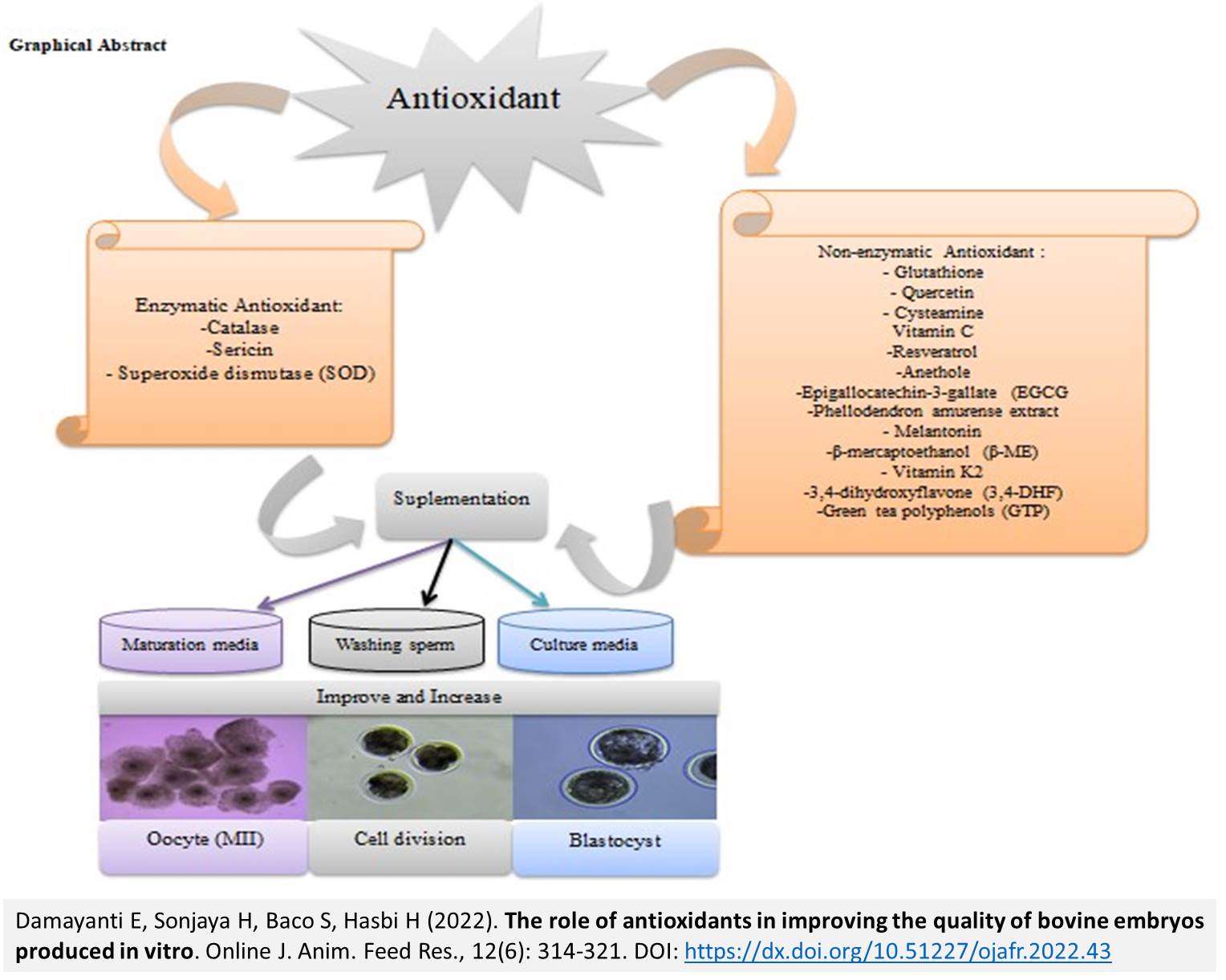 Online J. Anim. Feed Res., 12(6): 324-332, 2022; pii: S222877012200043-12
Online J. Anim. Feed Res., 12(6): 324-332, 2022; pii: S222877012200043-12
DOI: https://dx.doi.org/10.51227/ojafr.2022.43
Abstract
Antioxidants are molecular compounds that can give their electron structure to free radical molecules without disturbing them and can break the chain of free radical compounds. Antioxidants that can be used include enzymatic and non-enzymatic antioxidants. Supplementation of antioxidants into maturation mediums or cultures with the right concentration can efficiently improves oocyte maturation, cell division, and embryo quality in bovine. Enzymatic and non-enzymatic antioxidant supplementation of the maturation medium increase the number of oocytes that reach metaphase II (MII). Furthermore, the supplementation of both antioxidants in maturation and culture mediums are also able to increase cell division and embryo that reaches blastocyst. Non-enzymatic antioxidant supplementation is more effective than enzymatic antioxidants in improving the maturation and division of cells in the production of bovine embryos in vitro. In conclusion, non-enzymatic antioxidant supplementation is more effective in supporting embryonic development in vitro.
Keywords: Bovine, Embryo, Enzymatic antioxidants, Non-enzymatic antioxidants
[Full text-PDF] [Scopus] [ePub] [Export from ePrint]
Review
Quantitative and qualitative traits characterisation of indigenous chickens in Southern African countries
Hlokoe VR, and Tyasi TL.
Online J. Anim. Feed Res., 12(6): 333-340, 2022; pii: S222877012200044-12
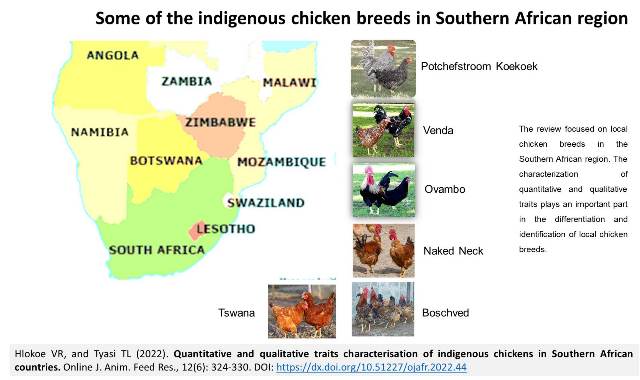 DOI: https://dx.doi.org/10.51227/ojafr.2022.44
DOI: https://dx.doi.org/10.51227/ojafr.2022.44
Abstract
Indigenous poultry production is important to human lives as they alleviate poverty by providing an affordable source of animal proteins. Besides, it serves as the easiest source of income for rural farmers in developing countries. The current review was conducted to evaluate the research findings of indigenous chickens’ quantitative and qualitative traits characterisations in Southern African countries. Quantitative and qualitative traits characterisation is the first step for genetic improvement in livestock. The documents used in the review were attained from different search engines, most of which were published lately (after 2010). Potchefstroom Koekoek, Venda, Naked Neck, Ovambo, Boschveld and Tswana indigenous chicken breeds in the Southern African countries were characterised. The studies suggest that there are variations in quantitative traits including live weight, egg weight, wing length, comb length and shank length and qualitative traits including feather color, comb type, comb color and eggshell color of indigenous chickens of Southern African countries. The single red comb types and red wattles were observed in most indigenous chicken breeds in Southern African countries. The present review concludes that the characterisation of quantitative and qualitative traits assists greatly in the differentiation and identification of indigenous chicken breeds.
Keywords: Breed; Characterisation; Chickens; Quantitative traits; Qualitative traits.
[Full text-PDF] [Scopus] [ePub] [Export from ePrint]
Research Paper
Nutritional evaluation of Pentas schimperiana as livestock feed and potential protein supplement
Woretaw T and Beyero N.
Online J. Anim. Feed Res., 12(6): 341-349, 2022; pii: S222877012200045-12
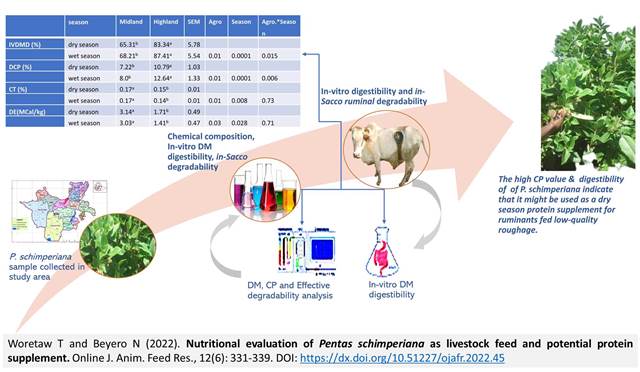 DOI: https://dx.doi.org/10.51227/ojafr.2022.45
DOI: https://dx.doi.org/10.51227/ojafr.2022.45
Abstract
Pentas schimperiana is locally available and dominantly used as a dairy cattle feed in the Dawuro zone's Maraka district, Ethiopia. There is some information about its utilization practice, however, data on its nutritional benefit is limited. This research aimed to examine the chemical content and digestibility of P. schimperiana for use as cattle feed during the dry season. For this study, a 2x2 factorial design with two agro-ecologies (midland and highland) and two seasons (wet and dry) was used for this study. P. schimperiana leaves, twigs and stems were gathered and processed for laboratory analysis from two agro-ecologies and two seasons. The chemical composition, in-vitro digestibility, and in-Sacco degradability of the samples were determined after incubation at 0, 6, 12, 24, 48, 72, and 96 hours. Effective degradability (ED) and Potential degradation (PD) were computed. The collected data were subjected to an Analysis of Variance and the means that had significant deference, the mean separation was performed by Tukey with alpha level of 0.05. In-vitro dry matter digestibility (IVDMD) (87.41%) and crude protein (CP) (17.39%) were significantly higher in highland. Digestible crude protein (DCP) was significantly larger in dry than in the wet season with the content of neutral detergent fiber (NDF), acid detergent fiber (ADF), and acid detergent lignin (ADL) decreased. During the wet season, potential degradability (PD) and effective degradability (ED) of DM were highest in the highland with a decrease in leg time, which was related to the low content of ADF, ADL, NDF, tannin, and high CP in vegetative stages of P. schimperiana. The result indicates that P. schimperiana might be used as supplementary feeds to enhance utilization of low-quality feed resources and improve the performance of ruminants during the dry season when feed is scarce.
Keywords: Chemical composition, Degradability, Digestibility, Pentas schimperiana, Tannin.
[Full text-PDF] [Scopus] [ePub] [Export from ePrint]
Research Paper
Morphometric characterization of New Zealand white rabbit raised at different areas
Setiaji A, Sutopo S, Lestari DA, Kurnianto E, Novianti ME.
Online J. Anim. Feed Res., 12(6): 350-355, 2022; pii: S222877012200046-12
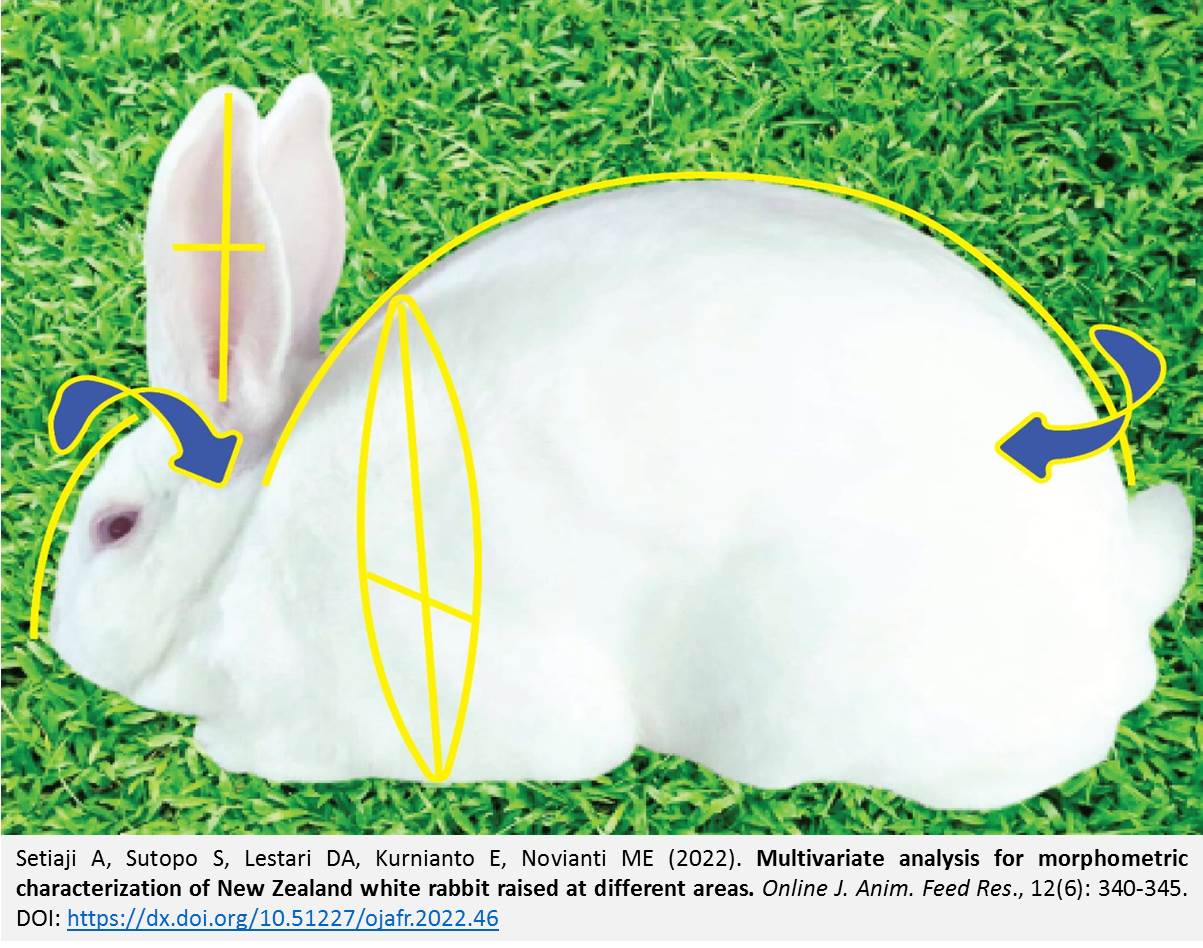 DOI: https://dx.doi.org/10.51227/ojafr.2022.46
DOI: https://dx.doi.org/10.51227/ojafr.2022.46
Abstract
The study aimed to morphometric characterization the New Zealand White (NZW) doe at three different areas. The materials used were 295 heads of NZW doe rabbits from 29 farms located at different areas. Twelve morphometric characteristics consist of body weight, eight body measurements, and three-body indices. Data analysis was performed by Mixed model, Pearson’s correlation, Principal component, and Canonical discriminant procedures. The most of parameters showed significant differences among areas. The heaviest body weight (4.71 kg) was observed in low-land and the lightest in medium land (3.54 kg). Most of the morphometric characters showed positive correlations with each other. Results of principal component show that the body indices of NZW doe raised in three different areas were similar. Canonical discriminant analysis showed that low-land was more favorable than high-land and medium land. In conclusion, The variation in size difference for morphometric characters of female New Zealand white rabbit could be explained by body index and thoracic index. The morphometric characteristics of New Zealand white doe raised in low-land area were superior to those raised in high-land and medium land areas.
Keywords: Body index, Eigenvalues, Least-square means, Phenotypic correlation, Thoracic index.
[Full text-PDF] [Scopus] [ePub] [Export from ePrint]
Research Paper
The potential of seed germination inhibition test for early pregnancy detection and improved reproductive efficiency of cattle in Zambia
Sianangama PC, Mtonga M, Harrison SJ, and Abigaba R.
Online J. Anim. Feed Res., 12(6): 356-362, 2022; pii: S222877012200047-12
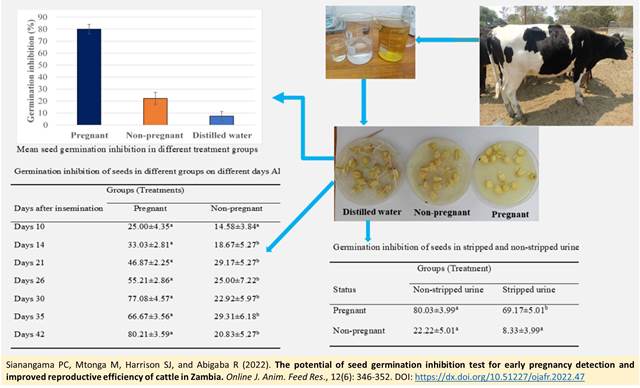 DOI: https://dx.doi.org/10.51227/ojafr.2022.47
DOI: https://dx.doi.org/10.51227/ojafr.2022.47
Abstract
Early pregnancy diagnosis is an important management practice for reducing calving interval, increasing cattle reproductive efficiency, and the overall herd productivity. This study was undertaken to assess the viability of seed germination inhibition technique (Punyakoti test) for early pregnancy detection in cattle under the tropical rearing conditions. Twenty-four randomly selected cows were used for the experiment. Urine samples were collected and subjected to Punyakoti test, using maize seeds, within 6 hours of collection. Descriptive statistics employing means and standard error were used to analyse data, also, inferential statistics including analysis of variance and t-tests were employed to ascertain differences between the variables under study. Urine from pregnant cows had the highest (80.03±3.99) inhibitory effect while the distilled water group had the least (7.50±3.81) mean seed germination inhibition. The means of germinated maize seeds in pregnant and non-pregnant cow urine treatment groups were significantly different. The means of germinated maize seeds in unstripped and stripped pregnant cow urine were significantly different, while the mean shoot length values for the same treatments were not significantly different. Urine from 42 days’ pregnant cows had the highest germination inhibition (80.21±3.59) while the least (25.00±4.35) was observed on day 10. The Punyakoti test reliably detected pregnancy starting from 26 days after insemination. In conclusion, this technique can be used for detecting pregnancy as early 26 days after insemination. The potential role of steroids and involvement of abscisic acid (ABA) in seed germination inhibition requires further investigation.
Keywords: Abscisic acid, Cattle, Maize, Pregnancy detection, Punyakoti test.
[Full text-PDF] [Scopus] [ePub] [Export from ePrint]
Research Paper
The effect of coconut meat waste supplemented with thermophilic bacteria and thermostable mannanase on performance, gut histomorphology and microbiota of broiler chickens
Harnentis, Amizar R, Nur YSh, and Huda N.
Online J. Anim. Feed Res., 12(6): 363-371, 2022; pii: S222877012200048-12
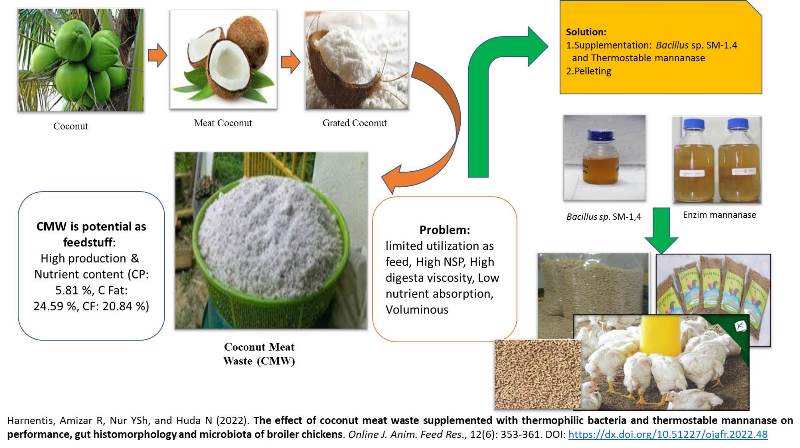 DOI: https://dx.doi.org/10.51227/ojafr.2022.48
DOI: https://dx.doi.org/10.51227/ojafr.2022.48
Abstract
An experiment was conducted on Arbor Acress broiler chicks to evaluate the effects of coconut meat waste (CMW) supplemented with 1010 CFU/kg CMW of thermophilic bacteria (Bacillus sp. SM-1.4) and 800 U/kg diets of thermostable mannanase on performance and gut histomorphology of broilers. One hundred and fifty of day-old chicks (unsexed) were used in this study. The birds were fed five diets containing coconut meat waste supplemented with bacteria and mannanases (CBM); 0% CBM, 10% CBM, 20% CBM, 30% CBM, and 40% CBM. Feed and water were available at all times. A completely randomized design was applied in this experiment with five diets and five replicate cages. The parameters determined are performance (feed consumption, body weight gain, and feed conversion ratio), gut histomorphology, and microbiota of broilers. Data were analyzed by analysis of variance according to a completely randomized design and Duncan's Multiple Range Test. Data indicated that feed consumption, body weight gain, and gut histomorphology of birds fed the CMW supplemented with thermophilic bacteria and thermostable mannanase were up to 30% higher than those of birds fed the non-supplemented (0% CBM) diet. The birds fed a 20% coconut meat waste diet supplemented with 1010 CFU/kg diet thermophilic bacteria, and 800 U/kg CMW thermostable mannanase had higher body weight gain than others and significantly (P<0.05) affected on microbiota of broiler. Adding coconut meat waste supplemented with thermophilic bacteria and thermostable mannanase did not affect the feed conversion ratio. In conclusion, up to 20%, CBM level in the diet could improving performance, gut histomorphology, and composition microbiota of broiler.
Keywords: Broiler, Coconut meat waste, Histomorphology, Microbiota, Thermophilic bacteria, Thermostable mannanase.
[Full text-PDF] [Scopus] [ePub] [Export from ePrint]
Research Paper
Analysis of physical and microbiological quality of raw camel milk in the Somali regional state of Ethiopia
Omer AG and Dol Ateye M.
Online J. Anim. Feed Res., 12(6): 372-378, 2022; pii: S222877012200049-12
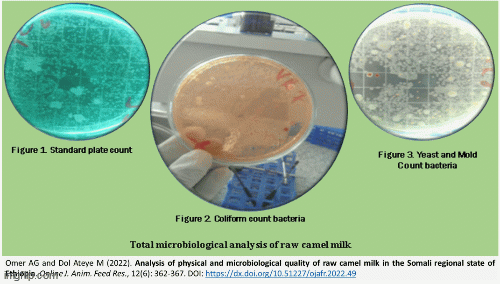 DOI: https://dx.doi.org/10.51227/ojafr.2022.49
DOI: https://dx.doi.org/10.51227/ojafr.2022.49
Abstract
The objective of this study was to determine the physical and microbial quality of raw camel milk along the milk market chain a total of forty-two raw milk samples were taken from milk producers (21 samples) and milk collection centers (21 samples). Each sample was analyzed for physical and microbial quality including temperature, pH, titratable acidity, specific gravity, and clot on boiling, the overall mean and standard deviation values were 27.93 oC, 6.29, 1.030 g/cm3, 0.95%, and 88.1% respectively. Microbial quality and safety attributes that include total bacteria count, coliform count, and yeast and mold counts were analyzed. The overall mean log10 counts per ml and standard deviation values for each total bacterial count, coliform count, and microbial analysis were 7.48 log10 CFU/ml, 5.85 log10 CFU/ml, and 4.78 log10 cfu/ml, respectively. The total bacterial count, coliform count, yeast, and mold counts were calculated and show that the milk collection center samples were significantly higher than milk samples obtained from household producers. This study indicated that the quality of camel milk in the study area had low quality and this could cause public risks through the consumption of raw camel milk produced and sold under the present production and handling conditions along the chain. Thus, these calls for strict hygienic measures to improve the quality and safety of camel milk produced and marketed in the study area.
Keywords: Camel milk, Hygiene, Microbial quality, Raw milk, Somali Regional State.
[Full text-PDF] [Scopus] [ePub] [Export from ePrint]
Research Paper
Understanding lipid quality variability in Asia Pacific through comprehensive lipid evaluation tests
Ting JX, Thng A, Tay HR, Soo GH, and Ong HCh.
Online J. Anim. Feed Res., 12(6): 379-389, 2022; pii: S222877012200050-12
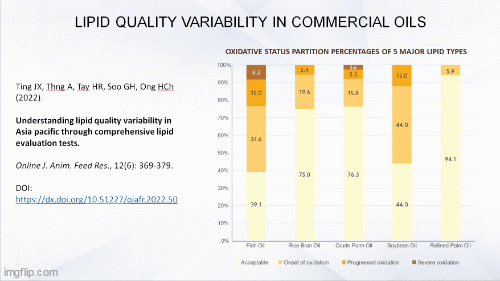 DOI: https://dx.doi.org/10.51227/ojafr.2022.50
DOI: https://dx.doi.org/10.51227/ojafr.2022.50
Abstract
The objective of this study was to investigate the variability in the oxidative quality and nutritional values of different lipid samples collected across Asia-Pacific region. The oxidative quality was evaluated through the peroxide value (PV) and malondialdehyde (MDA) content, while the free fatty acid (FFA) content and degree of fatty acid saturation (U/S ratio) were two essential parameters used to understand the nutritional values or metabolizable energy (ME) values of lipid samples. A total of 1221 lipid samples were collected and analyzed over a period of 10 years. The study showed high variability in oxidative quality between the lipid samples. Due to higher unsaturated fatty acid composition, the oxidative quality for most of the fish oil and soybean oil was at a less favorable range compared to rice bran oil, crude palm oil, and refined palm oil. The standard deviation of free fatty acids (FFA) content of soybean oil and refined palm oil was smaller compared to tallow, rice bran oil, crude palm oil, and fish oil. Fish oil and soybean oil had a higher standard deviation in U/S ratio. Variations in the FFA content and U/S ratio contributed to fluctuation in ME values.
Keywords: Fatty acid composition, Hydrolysis, Lipid quality, Metabolizable energy, Oxidation.
[Full text-PDF] [Scopus] [ePub] [Export from ePrint]
Research Paper
Effects of dietary supplementation of turmeric and black cumin powder on performance and blood parameters of native chickens
Suwarta FX, Suryani ChL, Astuti N, and Amin L.
Online J. Anim. Feed Res., 12(6): 390-397, 2022; pii: S222877012200051-12
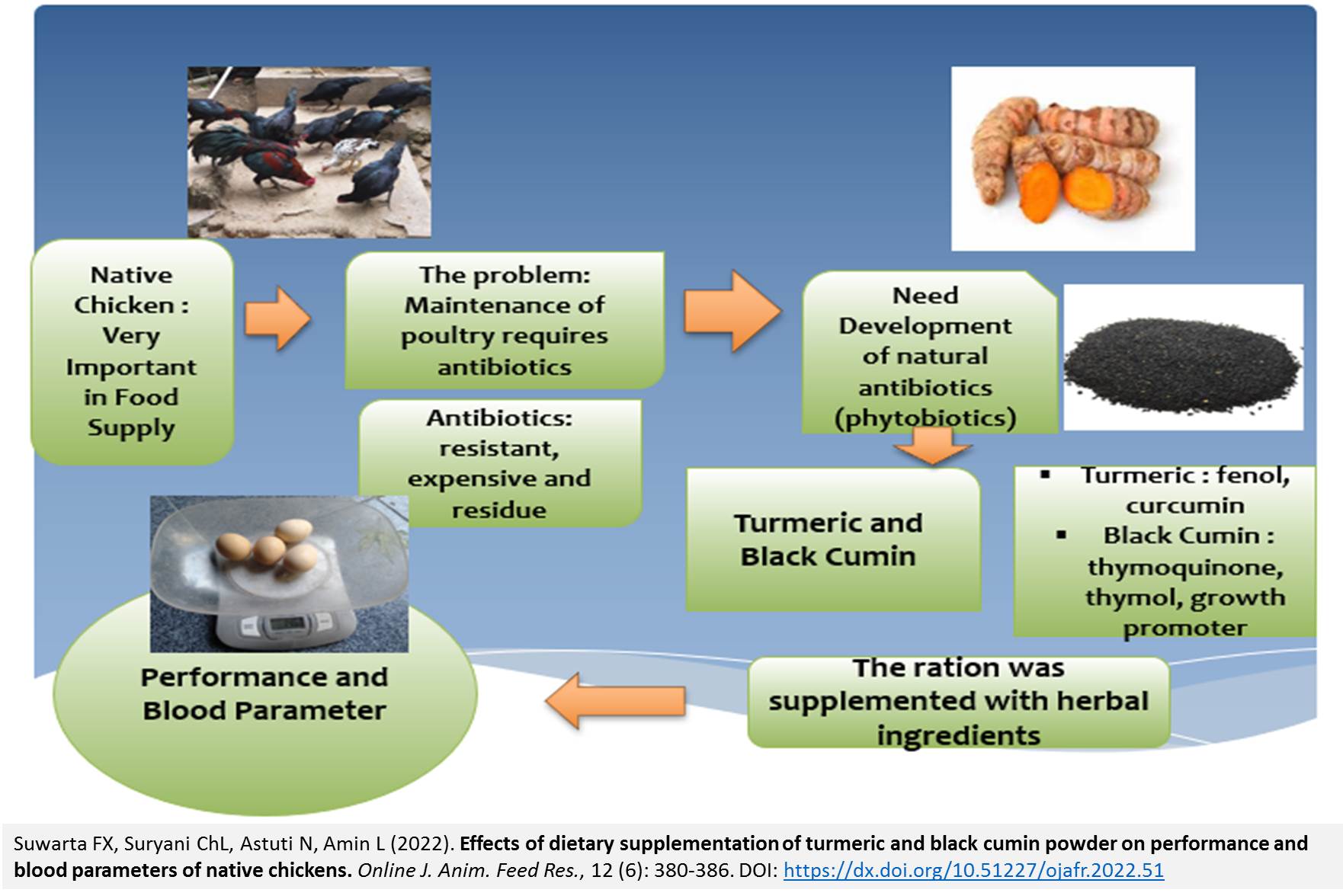 DOI: https://dx.doi.org/10.51227/ojafr.2022.51
DOI: https://dx.doi.org/10.51227/ojafr.2022.51
Abstract
This study was conducted to determine the effect of supplementation of a mixture of turmeric and black cumin powder on the production performance, blood parameters, and quality of native chicken eggs. Ninety-six female native chickens aged 17 weeks were randomly allocated in a completely randomized design into four treatments. The four treatments were differentiated based on the level of supplementation of a mixture of turmeric (TP) and black cumin powder (BCP), namely T0: Control (without a mixture of TP and BCP); T1: (2.5 g TP + 2.5 g BCP)/kg ration; T2: (5 g TP + 5 g BCP)/kg ration and T3: (7.5 g TP + 7.5 g BCP)/kg ration. Each treatment was repeated 3 times, using 8 native chickens. The variables measured were blood parameters including Hemoglobin (Hb), hematocrit, total red blood cells (RBC), white blood cells (WBC), blood cholesterol and triglycerides; and also, the performance variables of feed consumption, egg production (HDA), body weight at 34 weeks, egg weight, egg mass, feed conversion, yolk weight, shell weight, shell thickness, yolk color index, cholesterol, LDL and HDL of yolks. The Data were collected for 16 weeks and analyzed by variance analysis. The results showed that supplementation with a mixture of TP and BCP increased feed consumption; HDA; body weight; egg mass; shell weight, thickness, and yolk color (P<0.05). Egg weight and yolk weight were not significantly different. TP + BCP supplementation significantly reduced feed conversion, cholesterol level, HDL, and LDL. Increased TBCP supplementation increased Hb, hematocrit, red blood cells and white blood cells and significantly decreased cholesterol, lipoproteins, and triglycerides in the blood (P<0.05). It was concluded that TBCP mixture supplementation could improve production performance, some of blood parameters, and quality of native chicken eggs.
Keywords: Black cumin, Native chicken, Performance, Turmeric, Yolk
[Full text-PDF] [Scopus] [ePub] [Export from ePrint]
Previous issue | Next issue | Archive
This work is licensed under a Creative Commons Attribution 4.0 International License (CC BY 4.0).![]()
| < Prev | Next > |
|---|


